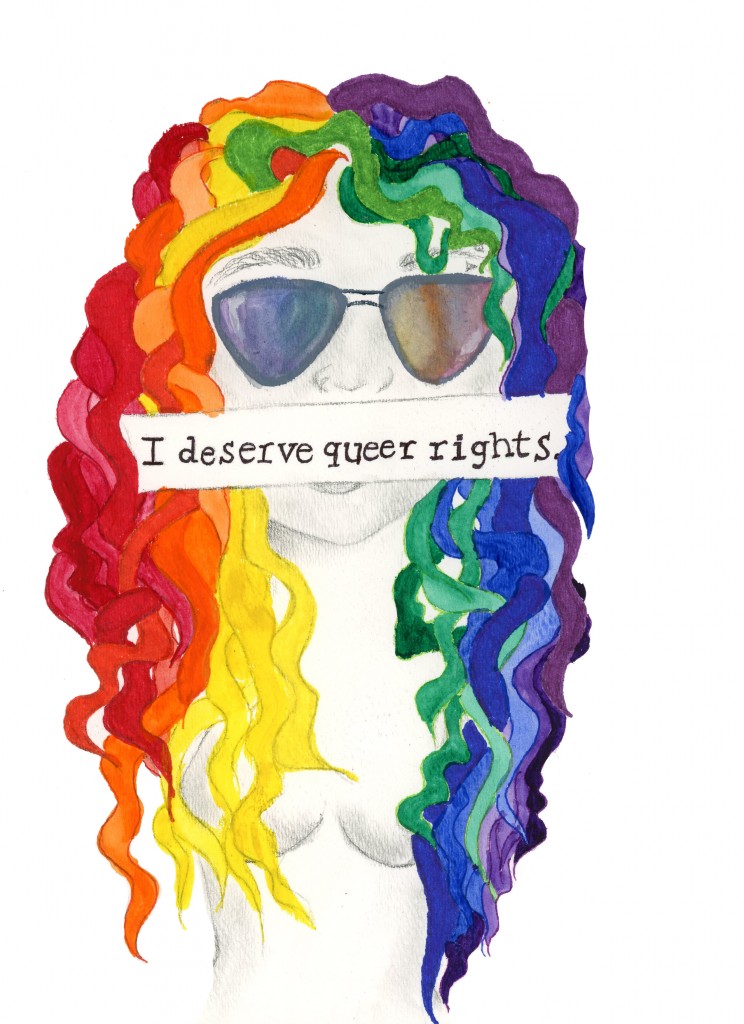The Invisibility of (queer) Women
“Gay-marriage” is wrong. Not because two boys or two girls shouldn’t get married, but because there are more sexual orientations than just gay and straight. While same-sex marriage is an important issue, the arguments for and against it often boil down to raising a family and the possibility of adoption, both of which are frequently centered around men. Far too often, the discussion about queer rights is simplified into the issue of gay men getting married.
There is more than just gay and straight. There are other non-straight sexual orientations such as pan and bisexual which are not only ignored in the public discussion of queer rights but also trivialized, mocked and disregarded in and out of the “gay” community.
Many people don’t believe bisexuality exists and simplify it as a sort of indecisiveness, confusion or experimentation. There are others who acknowledge it only for its sex appeal as girl-on-girl entertainment for straight men. This then leads to the tendency to lump all non-straight people into one exclusive category or to ignore individual identities completely by using the term “gay-marriage” instead of “same-sex marriage” as well as “gay rights” to mean “queer rights.”
“Queer” is an umbrella term for sexual and gender minorities. Queer rights therefore apply to the entire LGGBTQQIAAP community–– Lesbian, Gay, Gender-queer, Bisexual, Transgender, Queer, Questioning, Intersex, Asexual and Pansexual people and their Allies–– which most people just know as LGBT.
But, “gay” is far too often used in place of an umbrella term for any issues concerning those of us with what some people still consider “deviant” sexual identities. The Huffington Posts’s section dedicated to the queer community for example is titled “Gay Voices,” even though it has categories for more than simply “gay” issues. Why can’t it be “Queer Voices?”
Why does everything queer have to be gay? It seems like this is something more for people outside the queer community who need to see a word they find familiar, and who may also associate queer with an “offensive” term for “a homosexual man.” While queer can be derogatory it’s usually in the context of “those damn queers” or some other complaint using queer as a noun, with a statement such as “Hello. I’m queer” (used as an adjective) serving as an affirmation of an identity.
The other part of the issue is centering the discussion around men. I saw a picture on Facebook of Tim Gunn holding a piece of paper that read “People against same sex marriage say it will tear the social fabric of society. Do you really think gay people would do anything to harm fabric?” While this is a clever and funny commentary, it is entirely centered around gay men. In playing with a stereotype, it mocks ignorance.
However, it only includes gay people in same sex marriage and relies on a gay, male stereotype. Lesbians aren’t associated with fashion (other than supposedly ditching it in favor of flannel and combat boots). Why isn’t there an add playing on the lesbian and Home Depot love affair stereotype that reads something like“Ruin marriage? Gay people prefer to fix things!” that shows some badass woman with a rainbow power-drill?
Other examples of male-centric thinking in same sex marriage can be seen as people rally to defend marriage equality in comment threads in response to bigoted statements on the Internet–– such as reactions to a quasi-logical letter to the editor “A defense of traditional marriage in the U.S.” from the Kentucky Kernel (a University of Kentucky publication) written by freshmen political science major Michael Butler. When I first read it there were around 39 comments. One of the arguments in the letter was about how marriage is for having children.
What both the writer and many of the commentators ignore is that there are women who want to marry other women and they have uteruses and uteruses (unless there are fertility issues) equal babies. The commentators repeatedly mention adoption and in-vitro surrogate options or even having a child from a previous relationship, which are basically the only options for same-sex male couples but not the only ones for same sex female couples, effectively ignoring female reproductive capabilities. The defense is definitely admirable––beautiful even–– but it isn’t enough when a crucial counter-argument is not mentioned because no one thinks about women–– somewhat ironic in a time where women’s reproductive rights are on the forefront of the political arena.
It seems that women only matter in the context of women’s issues specifically, not in the broader scope of fighting for equality. Men are consistently the focus of civil rights issues not because women are apathetic or incapable, but because it’s a man’s job to fight, to assert his masculinity. Whether or not fighting (for anything) is a purely “masculine” aspect, masculinity isn’t a quality exclusive to men. You’d think people would at least pay attention to the “manly” queer woman stereotype (as misguided as it can be) and include butch lesbians.
Obviously, there’s more to expanding the general discussion of queer rights outside the LGBTQ community than just integrating gender equality into the issue of marriage equality. There are numerous other issues caused by the continuation of gender roles affecting not only what it means to be non-heterosexual man or woman but also what it means to be genderqueer or trans and the everyday problems people face. But eliminating male-bias and the suffocating mis-recognition in the fight for same-sex marriage is a good place to start.
Vivienne Muller (SC ’16) plans on majoring in Creative Writing and History with a minor in dance. Fun fact? She REALLY, REALLY likes cats.

![[in]Visible Magazine](https://community.scrippscollege.edu/invisible/wp-content/uploads/sites/5/2011/04/Invisible-Masthead-2011-Spring1.png)








No comments yet... Be the first to leave a reply!